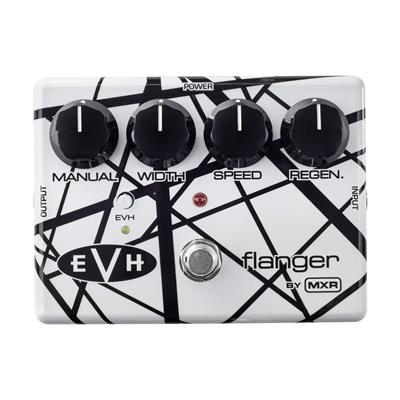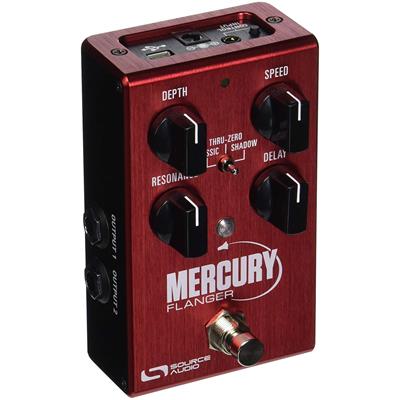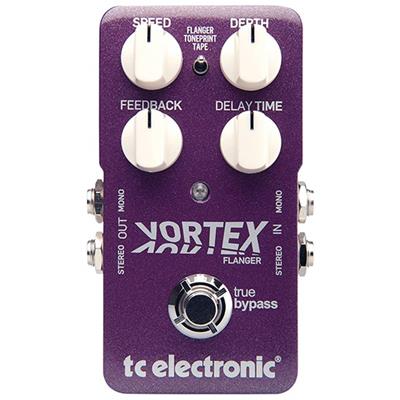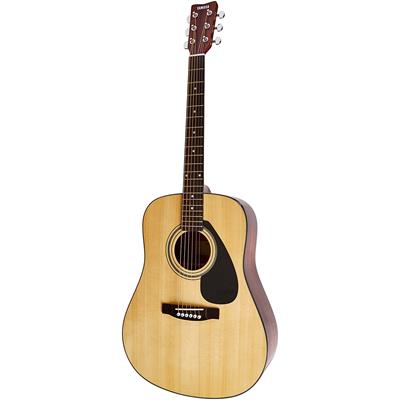Flange is known to be one of the most hated effects. Why, you might wonder. The reason for this is as simple as it can get: it tends to overpower your sound quite a bit, meaning that your tone will be hard to control. However, if you are up for a challenge, this effect will completely change everything you know about music.
Flange can be quite intense, but if you master it, you will end up with mesmerizing results. There are a lot of confusing things to consider while utilizing this bad boy, but do not worry, that is why I am here. In the following article, I will try to explain the flangers in the easiest way possible, give you a little tour through time, and provide you with some tips and tricks on how to use them. Are you ready to accept the challenge? If so, follow me in the world of the best flanger pedals and enjoy the ride!
What’s The Best Flanger Pedal
| Image | Amplifier Model | ||
|---|---|---|---|
 | MXR EVH117 Flanger Guitar Effects Pedal |  (4.9 / 5) (4.9 / 5) | Check on Amazon |
 | Electro-Harmonix Deluxe Electric Mistress XO Guitar Flanger |  (4.9 / 5) (4.9 / 5) | Check on Amazon |
 | Source Audio SA240 Mercury Flanger Effect Pedal |  (4.9 / 5) (4.9 / 5) | Check on Amazon |
 | Boss BF-3 Flanger Guitar Effects Pedal |  (4.8 / 5) (4.8 / 5) | Check on Amazon |
 | TC Electronic Vortex Flanger Pedal |  (4.8 / 5) (4.8 / 5) | Check on Amazon |
 | MXR M152 Micro Flanger |  (4.8 / 5) (4.8 / 5) | Check on Amazon |
 | Mooer Eleclady Classic Analog Flanger |  (4.8 / 5) (4.8 / 5) | Check on Amazon |
 | Donner Jet Convolution - Classical Analog Rolling Flanger |  (4.7 / 5) (4.7 / 5) | Check on Amazon |
 | Joyo JF-07 Classic Flanger Guitar Effect Pedal |  (4.7 / 5) (4.7 / 5) | Check on Amazon |
 | Nady FL-10 Flanger Pedal |  (4.7 / 5) (4.7 / 5) | Check on Amazon |
MXR EVH117 Flanger Guitar Effects Pedal

MXR EVH117 is a signature pedal developed in collaboration with Eddie Van Halen himself. If you love the music of this guitar virtuoso, then you have to get this pedal. Recreating the sound of “Unchained” has never been easier – you just have to press the EVH button on the pedal. This way you will activate a preset with Van Halen’s favorite settings. Impressed yet? There is more. EVH117 has four knobs that allow you to control the effect: Manual modifies the amount of delay in your flange; Width balances out the mixture of your wet and dry signals; Speed sets the rate of the effect; and Regeneration modifies the feedback of your sound. This is an analog pedal equipped with a good old Bucket Brigade System. When it comes to performance, the EVH117 excels at producing impressive tones that span a wide spectrum, from gentle undulations to powerful jet-like streams, reminiscent of the iconic Van Halen sound. Whether you aspire to recreate the legendary artist’s signature sound or simply desire a top-notch flange effect, this pedal is a perfect choice.
Pros:
- Versatile
- Powerful sound
- EVH button
- Quality performance
Cons:
- A bit pricier than original
- Increases volume when activated
Electro-Harmonix Deluxe Electric Mistress XO Guitar Flanger

EHX Deluxe Electric Mistress XO is the revamped version of the original and one of the best flanger pedals. They decided to tailor the pedal to up-to-date needs and developed a more compact design. Apart from modernizing the power supply, they added a true bypass feature as well as a LED indicator. The rest is the exact replica of the original. Deluxe Electric Mistress XO has three knobs to work with: Color allows you to adjust the intensity of the effect according to your music and preferences, Range sets the lower and higher margins of the frequency, giving you the option to swing between narrow sweeping and bass (and everything in between), while Rate modifies the speed of the flange. Additionally, this pedal has a Filter Matrix toggle. This is where things get more interesting. In matrix mode (where Rate loses all of its functions) you can create chime-like tones if you tweak Color and Range properly. If you loved your original Deluxe Electric Mistress, the XO version will satisfy even your deepest desires.
Pros:
- True bypass
- Sweet analog tones
- Modes give you a great deal of versatility
Cons:
- Basic controls
- Might drop your volume a little
Source Audio SA240 Mercury Flanger Effect Pedal

There is no doubt about the exceptional quality of Source Audio products. Throughout the years, their devices have consistently showcased remarkable performance, and they continue to excel even to this day. Mercury seems to be in the same league. The controls on this one are quite standard to flangers: Depth modifies the intensity of the effect, Speed sets its rate, Resonance fluctuates the frequencies to create jet-like sounds, while Delay is quite self-explanatory. Apart from the knobs, Mercury has a toggle switch, which shifts between three modes: Classic mode is your beloved effect from your vintage pedals, Thru-Zero (Tape Flange) creates a beautiful effect by mixing and matching dry and wet signals, while Shadow is a straightforward jet whoosh. Additionally, this pedal can be paired with Neuro App, which opens up a lot more sonic possibilities. It can also be connected to a MIDI controller which gives room to 128 presets. I have no idea how you can say no to so many features.
Pros:
- Extremely versatile
- Offers a lot of control
- Can be paired with an App and other devices
Cons:
- Mode selector is a bit hard to access on the fly
Boss BF-3 Flanger Guitar Effects Pedal

Boss products have always been a subject of intense debate, provoking a wide range of opinions. Nevertheless, one undeniable aspect is the exceptional quality of their devices. The sturdy and resilient construction, characterized by solid metallic chassis, ensures durability and reliability throughout performances. As for me, I reckon that Boss pedals deliver great sounds at a reasonable price. BF-3 falls into the same category. It is way more than just a regular flanger. Let’s dive into discussing the features and you will know what I am talking about. First of all, it has several knobs that allow you to shape different parameters of the effect. Manual/Resonance sets the frequency to which the flange is applied and balances out the feedback. Depth and Speed are your typical controls (depth disables the manual when turned all the way up). You can choose between different modes: Standard (which is obviously a standard flange), Ultra (an intensified version of the effect), Gate/Pan (which changes up depending on mono and stereo features), and Momentary (press and hold operation). The Tap Tempo and dedicated Bass input are standout features that truly elevate this pedal. Personally, I find it incredibly impressive. Once again, kudos to BOSS for a job well done.
Pros:
- Extremely durable
- Easy to operate
- Quality sound
- Flexible and versatile
Cons:
- Does not have a true bypass
- Can be a bit noisy
TC Electronic Vortex Flanger Pedal

It has been a rule for a while now that you cannot go wrong with TC Electronic. They stepped up their game by enabling a TonePrint. With the help of this application, even the simplest pedal turns into a beast of features and opens up a whole new level of sonic possibilities. Vortex is no exception. It has a toggle switch, which activates this parameter and allows you to tweak your sound as a professional. The same switch shifts between two types of flange: Classic and Tape, which means you have even more versatility on hand. This pedal has four basic knobs that you will see almost on every other flanger: Speed, Depth, Feedback, and Delay Time. Since there is nothing unique about them (apart from being quite sensitive and intuitive), I will rather concentrate on more interesting features. Speaking of which, Vortex has two internal dip pots, that allow you to switch between buffered bypass and dry kill. Additionally, it offers mono and stereo outputs which makes it extremely flexible. In short, this is one of the best flanger pedals with a lot of tweakable features.
Pros:
- TonePrint enabled
- Versatile
- Straight-forward controls
- Sensitive knobs
Cons:
- A bit loud
- Might take some tweaking to achieve desired sound
MXR M152 Micro Flanger

It does not get simpler than MXR M152. This is a compact pedal, which comes in a tank-like, metal body. It features an analog circuit with well-known Bucket Brigade chips and guarantees to deliver a sweet, warm flange. This micro-unit is very easy to operate since it has only two knobs to work with: Rate allows you to control the speed of the effect, while Regen takes care of the intensity and depth. Even though you might think that these features are not something to write home about, they are more than enough to dial in the tone you want. M152 is a true bypass, meaning that your tone will not be colored when the pedal is switched off. As far as the performance goes, this micro pedal can deliver anything from subtle flange to twisting jet heaven. The price, the size, and the quality of sound make this unit worth a place on your pedal board.
Pros:
- Small size
- Unique vintage sound
- Simple and powerful
Cons:
- Does not give you an extreme flange
- AC adapter jack is on the side, which makes it difficult to access
Mooer Eleclady Classic Analog Flanger

It is not a secret for anyone that Mooer makes copies of famous brands and sells them at a fraction of the price. This time it has developed a smaller and cheaper version of EHX Deluxe Electric Mistress. Eleclady promises to deliver the legendary tones of that famous pedal. It has three knobs: Color modifies the amount of the effect, Rate sets the speed, and Range modifies the depth of the flange. It also has a toggle switch that lets you choose between Filter and Normal modes. Compared to Deluxe Electric Mistress, Eleclady is a bit harsher and works better with a clean channel. While it’s undeniable that the build quality falls short and requires frequent adjustments of the knobs to attain the desired sound, this option presents a compelling choice for those seeking a blend of ’70s tones reminiscent of Pink Floyd, serving as an excellent alternative to EHX pedal.
Pros:
- Affordable
- Does what it is supposed to
- Delivers a decent flange
Cons:
- Color can get a bit out of control
- Can drop your volume if set incorrectly
Donner Jet Convolution – Classical Analog Rolling Flanger

Donner has been a lifesaver for us budget players for a while now. They produce extremely inexpensive pedals that offer quite a decent performance. Jet Convolution comes from the same league and offers everything you would expect from a flanger pedal. It is featured in a compact body with a classic Donner design. The controls are quite simple on this one: Color adjusts the depth of the effect, Rate allows you to shift between different speed parameters, and Range does exactly what the name indicates. Apart from mainstream controls, this pedal has a toggle switch that shifts between two modes: Normal delivers classic flanger tones, while Filter is basically a manual mode. Jet Convolution promises to be a true bypass (cannot swear by that one). This pedal gives you a pretty amazing bang for the buck.
Pros:
- Extremely inexpensive
- Decent performance
- Compact design
- Classic flanger tones
Cons:
- Bypass is not that true
- Does not have a battery option
Joyo JF-07 Classic Flanger Guitar Effect Pedal

Joyo JF-07 Classic Flanger is yet another one in the series of affordable pedals. At first glance, you will not even think that it is cheap since the amount of control it delivers is quite surprising for the price. Its build quality is relatively good as well and could even take the abuse of stage performance. Joyo decided to pack all the essentials in terms of knobs: Regen, Delay Time, Width, and Speed. There is not much else you would need to create a killer flanger effect. These knobs are quite interactive, meaning that tweaking one will result in changing the performance of the other. It is not as precise as its higher-end rivals, but you cannot actually ask for that in this price range. In my book, JF-07 offers more than enough in order to be a proud member of your pedal family. So, what are you waiting for?
Pros:
- Does not have any noise
- Budget-friendly
- Delivers quality effect
Cons:
- A bit big for the features it offers
- Can have a slight tone loss
Nady FL-10 Flanger Pedal

We cannot skip over Nady when talking about affordable and quality products. Their pedals always offer a solid chassis with powerful performance. FL-10 is no exception to that rule since the sound it produces can easily compete with that of more expensive pedals. When it comes to knobs, we have a typical deal: Manually sets the frequency range which will be affected by the flange, Depth and Rate modify the intensity and the speed of the effect, while Res (Resonance) controls the amount of feedback applied to your signal. FL-10 produces a sound that can go from subtle to swirling jet tones. It does so without depriving your original signal of its nature and unique qualities. This pedal maintains the perfect balance between wet and dry tones. It has a LED indicator, which will tell you whether the unit is operating or not. These lights will go dim when the battery is draining, so you will not end up with the pedal stopping in the middle of a performance.
Pros:
- Extremely affordable
- Well-built
- Wide range of sound
Cons:
- Might be a bit loud
- Will not replace your go-to ‘80s flanger
What does a flanger pedal do?
Flanging is an audio effect that occurs as a result of merging two signals together. It is created by messing with delays: one part of the sound is detained by a certain amount of time, which fluctuates slowly. This way a sweeping is produced, generating the feel of the comb filters – the frequency spectrum is altered by varying peaks and notches. The movement of the effect is dynamic and gradual, which develops a distinctive sound. Oftentimes, the wet signal (the output) is put back in to the input and creates a resonance (a.k.a. feedback). This deepens the sound even more and increases the number of peaks and troughs in the frequency. Sometimes the phase of the wet signal is altered as well. These subsequently result in producing an array of sonic possibilities. As a pedal, a flanger does the same thing. It mixes up two delayed signals that are harmonic in nature.
History of flange
Back in the day, the most popular way of producing the effect was by manually altering the playback of different sources. This was made possible by using the tape machines to which the music was recorded concurrently. This sound was then played again in sync, which was ultimately fed back to a third recorder. One of them was slowed down by the engineer with the help of a tiny rim (a.k.a. flange). This way the classic “swoosh” or “sweeps” were created. It had one direction and would get mixed up with the other signal that was subtly behind when releasing the rim. By pressing it one more time, the flange would move in the opposite direction whilst the decks aspired to being in sync. This technique is hugely associated with the name The Beatles and their producer George Martin. The first usage of the effect can be found on the record “Tomorrow Never Knows” (1966). Since John Lennon and his band were big names back then, the popularization of the term still remains acquainted to their name. It was all thanks to Ken Townsend, who created an Artificial Double Tracking (ADT) system, which made it possible to deliver the effect with little to no effort.
Flanging was a sort of imperfection, a fault that would take place while recording long tracks in studio. In ‘60s and ‘70s, studio engineers suffered a great deal with this problem. Basically, the pioneering recording machines could not handle such a vast amount of tracks and tended to create flanging in dubbing. As you can see, this effect (now beloved by so many guitarist) was a badger and getting rid of it was not a child’s play.
However, there is a recurring controversy about the origins of the effect. No one really knows who was the first to invent the flange. One of the names that often comes up during this dispute is Les Paul. He was among those who have the right to claim the “ownership” of the discovery (somewhere between ‘40s and ‘50s). It is true, though, that the effect he used resembled phase shifting, since he utilized different disks on recorded and would play with altered speed (for instance, “Nuevo Laredo” and “Mammy’s Boogie”).
Furthermore, the claims continued. Toni Fisher’s “The Big Hurt” (1959) widely benefited from flange. David S. Gold and Stan Ross, who recorded this track, state that they were the ones who created the first commercial recording. One way or another, the effect was quickly caught on by various guitarist and became ubiquitous in a short time. Later recordings, such as “Itchycoo Park” by The Small Faces and “Bold as Love” by Jimi Hendrix also feature flanging.
Things took a new turn after the development of Bucket Brigade Delay (BBD) chips in 1969. As a result, Eventide developed the first flanger in 1974. This led to the popularization of rack-mounted flangers and the utilization of the BBDs in almost every unit. For this reason, no one really knows when and where the first flanger pedal was created. Anyways, nothing can interfere with the solid fact that ‘80s were the flourishing era for the effect and had a great impact on shaping the music industry of today.
What is the big difference between phase shifting and flange?
Let’s start off by saying that phase shifting and flange are not the same. The difference between them is not that audible, but they add individual shades to your tone. Imagine that you are choosing between red and pink, they both fall into the same category of warm colors but technically they are far cry from each other. The same goes with phase shifting and flange. Let me define them separately in order to make the distinction more noticeable.
Phasing is an effect that is created by the interference of the signal with all-pass filters. When it passes through the different stages of those filters, the phase of it changes. The altered tone is then added back to the original sound. This creates peaks and troughs in the frequency that are not in sync with each other. To illustrate more clearly, imagine a comb with teeth that are placed in tangled order and are spaced from each other differently.
Flanging, on the other hand, is the mixture of the original signal and the replica of itself that is delayed in time. To put it simply, everything here is in harmony and resembles a regular comb with even teeth. The peaks and troughs are in order as well. Both of these effects have the same characteristics and parameters, but flanging creates a more jet-like swirl.
This might seem like a meticulous thing at first glance, but knowing the distinction between your effects is an essential part of quality performance. When you know what each of them does and how, you turn into a sound engineer yourself and have the ability to shape your sound on a professional level. However, flanging belongs to the family of more difficult effects, meaning that you have to know exactly how to use them. I will show you certain ways of utilization of these pedals so that you have a general idea what to do with them.
How to use flanger pedals
First of all, it is crucially important to give flanger pedals the right place in your signal chain. We do not want to get a muddy sound with no audible character that resembles noise. We just want to achieve that extra texture and extreme sonic range that this effect provides us with. For this reason, there are certain simple “rules” to follow. If you want your sound to be saturated with Van Halen tones or simply be intense as hell, you should put your flanger after distortion pedals. This way you will add that jet swirl to a distorted signal, make it thicker and deeper. However, this is not an easy job and will require a lot of practice, since distortion is already a tricky thing on its own. Now, if you want to maintain a subtle flange with its beautiful swirls and sweeps, you should place the pedal before overdrives and fuzzes.
Second of all, you should always find your silver lining. Getting overboard with the effect can result in depriving your sound of its character, definition and clarity. While the right amount of flange will open up a bunch of new possibilities, its extensive utilization can ruin your sound. Do not forget, though, that these above-mentioned rules are not set in stone. They are based on the general idea of how things have worked in the past. You might be someone who will turn the music world upside down by forgetting all the “commands”. There is only one rule here: never stop experimenting!
Last but not least, even the simplest flanger comes with a set of four controls: Rate (Speed), Depth (Width or Range), Manual and Regen (Resonance or Feedback). Knowing what each of them does is the key to understanding the effect itself. Let’s dig in and discuss in depth the functions of these knobs.
Rate: there is nothing that special and difficult about this one, however, it is one of the essentials when it comes to creating well-structured flange. This knob messes with the frequency of the audio wave, which means it modifies the speed of the effect. This is the parameter which pretty much defines the flange itself. At lower settings, you will get a subtle effect and vice versa.
Depth: this knob lets you control the intensity of the effect. It allows you to be as precise as possible and add just the right amount of the effect to your sound. It also determines how organic the flange will be. Turning this knob clockwise will result in more artificial and intense effect and saturate your sound with that swirl. In other words, Depth changes the amplitude of the low-frequency oscillator (LFO).
Manual: this one sets the frequency to which the effect is applied. To put it simply, it sets the center point of the sweep. Manual and depth are quite interactive. The more you enhance the latter, the less effective the former becomes. Again, at higher settings, it can really change your tone and give you an extreme ethereal flange.
Regen: this knob modifies the amount of feedback added back to your sound. Though this is not the exact replica of that original tape flanger, but it takes after its predecessor quite a bit. This control defines the effect even more and gives you a lot of room for creating something unique.
One more thing that plays a huge role in creating this effect is the delay time. It ranges from 0.5 to 10ms. This is what makes flange so versatile. Modifying the delay time results in creating either filter or pitch effects. Thanks to comb filtering, this effect can do pretty much everything.
Conclusion
Congrats, my friend, you have finally made it till the end. I hope this journey was not too tiring for you. I tried my best to give you all the information you need in order to find the best flanger pedal and use it properly. One last piece of advice from me: take as many risks as you can, because you will not have another chance to shine. Experiment with your effects pedals and create something ethereal. Consider my suggestions, but never forget to find your own unique way in everything. Flange is scary at first, but it will be a piece of cake after some time. Plus, you have to be a real pro to use this effect. Hesitate no more, fella, you have amazing musical adventures ahead of you. Show the world who is the boss! Good luck!







